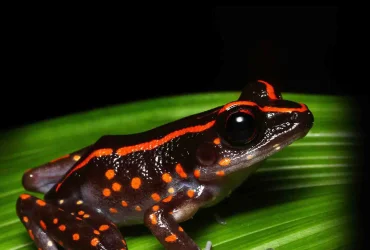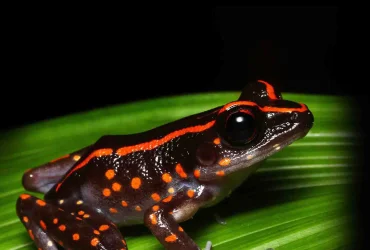Archives
 v14i2.385
v14i2.385eISSN: 1800-427X (online)
DOI:10.47605/tapro.v14i2.385
Submitted date: 27 January 2025
Accepted date: 21 April 2025
Published date: 28 November 2025
Pp. 309.
First record of the cobweb spider (Steatoda erigoniformis) from Gujarat
S.I. Parmar & P.J. Pandya
*Corresponding author. E-mail: pranavpandya1@yahoo.com
The genus Steatoda Sundevall, 1833 (Family Theridiidae) is represented by 6 species in India. Steatoda erigoniformis has been previously reported from Maharashtra and Rajasthan. Here we provide the first report from Gujarat State. The specimens were hand-collected and studied under a Zeiss Stemi 508 stereomicroscope, photographed using an Axiocam Erc 5s microscopic camera. The species was identified based on Levy & Amitai (1982) and Tripathi et al. (2023). The specimens have been deposited in the Department of Zoology, R.R. Lalan College, Bhuj-Kachchh, Gujarat, India.
Section Editor: Paula E. Cushing
DOI:10.47605/tapro.v14i2.385
Submitted date: 27 January 2025
Accepted date: 21 April 2025
Published date: 28 November 2025
Pp. 309.
First record of the cobweb spider (Steatoda erigoniformis) from Gujarat
S.I. Parmar & P.J. Pandya
*Corresponding author. E-mail: pranavpandya1@yahoo.com
The genus Steatoda Sundevall, 1833 (Family Theridiidae) is represented by 6 species in India. Steatoda erigoniformis has been previously reported from Maharashtra and Rajasthan. Here we provide the first report from Gujarat State. The specimens were hand-collected and studied under a Zeiss Stemi 508 stereomicroscope, photographed using an Axiocam Erc 5s microscopic camera. The species was identified based on Levy & Amitai (1982) and Tripathi et al. (2023). The specimens have been deposited in the Department of Zoology, R.R. Lalan College, Bhuj-Kachchh, Gujarat, India.
Section Editor: Paula E. Cushing
 v14i2.384
v14i2.384eISSN: 1800-427X (online)
DOI:10.47605/tapro.v14i2.384
Submitted date: 28 February 2025
Accepted date: 21 October 2025
Published date: 28 November 2025
Pp. 303–308.
Two newly recorded gobiid fishes (Sicyopus spp.) from Sumatra, Indonesia
T. Harefa*, H. Haryono, R. Rusdianto, F.M. Nur, D.F. Mokodongan & K. Wibowo
*Corresponding author. E-mail: tonisharefa@gmail.com
Fishes of the family Gobiidae, with an incredible diversity of over 2,000 species across 250 genera, represent one of the most diverse groups of vertebrates. The subfamily Sicydiinae is a speciose group of gobies that occupy tropical to temperate island streams in Indo-Pacific regions. Within this subfamily, the genus Sicyopus Gill, 1863, consists of eight valid species. This genus can be recognised by possessing widely spaced, mostly recurved, conical teeth on both the premaxillary and dentary jaws. Additionally, the premaxillary ascending process is narrowly tipped dorsally, and the tongue is free from the mouth floor. Recent ichthyofaunal surveys conducted in the streams of western Sumatra resulted in the collection of several specimens belonging to two distinct Sicyopus species. These findings represent novel records and significant range extensions for Sicyopus spp. within the Indonesian archipelago. Brief descriptions of the two newly recorded species based on the current collected specimens, as well as morphological character comparisons, are presented in this study..
Section Editor: Brendan C. Ebner
DOI:10.47605/tapro.v14i2.384
Submitted date: 28 February 2025
Accepted date: 21 October 2025
Published date: 28 November 2025
Pp. 303–308.
Two newly recorded gobiid fishes (Sicyopus spp.) from Sumatra, Indonesia
T. Harefa*, H. Haryono, R. Rusdianto, F.M. Nur, D.F. Mokodongan & K. Wibowo
*Corresponding author. E-mail: tonisharefa@gmail.com
Fishes of the family Gobiidae, with an incredible diversity of over 2,000 species across 250 genera, represent one of the most diverse groups of vertebrates. The subfamily Sicydiinae is a speciose group of gobies that occupy tropical to temperate island streams in Indo-Pacific regions. Within this subfamily, the genus Sicyopus Gill, 1863, consists of eight valid species. This genus can be recognised by possessing widely spaced, mostly recurved, conical teeth on both the premaxillary and dentary jaws. Additionally, the premaxillary ascending process is narrowly tipped dorsally, and the tongue is free from the mouth floor. Recent ichthyofaunal surveys conducted in the streams of western Sumatra resulted in the collection of several specimens belonging to two distinct Sicyopus species. These findings represent novel records and significant range extensions for Sicyopus spp. within the Indonesian archipelago. Brief descriptions of the two newly recorded species based on the current collected specimens, as well as morphological character comparisons, are presented in this study..
Section Editor: Brendan C. Ebner
 v14i2.383
v14i2.383eISSN: 1800-427X (online)
DOI:10.47605/tapro.v14i2.383
Submitted date: 11 February 2025
Accepted date: 21 July 2025
Published date: 28 November 2025
Pp. 299–302.
Anatomy of the nuchal glands in red-necked keelback (Rhabdophis subminiatus)
Y.N. Narindria, D.D. Cahyadi, A.Y. Prawira, S. Anita, A. Mori & S. Novelina
*Corresponding author. E-mail: savitri.novelina@apps.ipb.ac.id
The Red-necked keelback, Rhabdophis subminiatus (Schlegel, 1837), occurs in Indonesia on Java, Sumatra, Nias, and possibly Sulawesi. This species exhibits a suite of defensive displays, including body flattening, neck flattening, neck arching, neck butting, and dorsal-facing postures. Body flattening enlarges the body profile to intimidate predators, while neck flattening accentuates the bright red coloration of the neck, a visual warning linked to the location of the nuchal glands.
Section Editor: Patrick David
DOI:10.47605/tapro.v14i2.383
Submitted date: 11 February 2025
Accepted date: 21 July 2025
Published date: 28 November 2025
Pp. 299–302.
Anatomy of the nuchal glands in red-necked keelback (Rhabdophis subminiatus)
Y.N. Narindria, D.D. Cahyadi, A.Y. Prawira, S. Anita, A. Mori & S. Novelina
*Corresponding author. E-mail: savitri.novelina@apps.ipb.ac.id
The Red-necked keelback, Rhabdophis subminiatus (Schlegel, 1837), occurs in Indonesia on Java, Sumatra, Nias, and possibly Sulawesi. This species exhibits a suite of defensive displays, including body flattening, neck flattening, neck arching, neck butting, and dorsal-facing postures. Body flattening enlarges the body profile to intimidate predators, while neck flattening accentuates the bright red coloration of the neck, a visual warning linked to the location of the nuchal glands.
Section Editor: Patrick David
 v14i2.382
v14i2.382eISSN: 1800-427X (online)
DOI:10.47605/tapro.v14i2.382
Submitted date: 16 May 2025
Accepted date: 30 October 2025
Published date: 28 November 2025
Pp. 296–298.
Ophiophagy in the saw-scaled viper (Echis carinatus) from the UAE
P.L. Madurapperuma
*Corresponding author. E-mail: Pubudu.madurapperuma@emirates.com
The saw-scaled viper, Echis carinatus (Schneider, 1801), is a widespread venomous snake found across arid and semi-arid regions of the Middle East and South Asia. It is a generalist predator, known to feed predominantly on arthropods (particularly scorpions and centipedes), small lizards, rodents, and occasionally amphibians, and generally exhibits opportunistic feeding patterns typical of Old-World vipers. Despite a well-documented dietary breadth, no prior observations or records of ophiophagy (snake-eating behavior) exist for this species.
Section Editor: Ivan Ineich
DOI:10.47605/tapro.v14i2.382
Submitted date: 16 May 2025
Accepted date: 30 October 2025
Published date: 28 November 2025
Pp. 296–298.
Ophiophagy in the saw-scaled viper (Echis carinatus) from the UAE
P.L. Madurapperuma
*Corresponding author. E-mail: Pubudu.madurapperuma@emirates.com
The saw-scaled viper, Echis carinatus (Schneider, 1801), is a widespread venomous snake found across arid and semi-arid regions of the Middle East and South Asia. It is a generalist predator, known to feed predominantly on arthropods (particularly scorpions and centipedes), small lizards, rodents, and occasionally amphibians, and generally exhibits opportunistic feeding patterns typical of Old-World vipers. Despite a well-documented dietary breadth, no prior observations or records of ophiophagy (snake-eating behavior) exist for this species.
Section Editor: Ivan Ineich
 v14i2.381
v14i2.381eISSN: 1800-427X (online)
DOI:10.47605/tapro.v14i2.381
Submitted date: 22 January 2025
Accepted date: 22 October 2025
Published date: 28 November 2025
Pp. 293–295.
Book Review: Spesies Apakah Itu? [What Species Is That?]
Y. Purwanto, E. Munawaroh & W. Sujarwo
*Corresponding author. E-mail: wawan.sujarwo@brin.go.id
Indonesia is known as a megadiverse country with an extraordinary richness of biological diversity. However, the public’s understanding of what species are, how they are identified, and their primary importance for life and conservation remains limited. In this context, the book Spesies Apakah Itu? Menjawab Pertanyaan Pertama dari Penggemar Alam Sejati is a relevant and urgent work. The book “Spesies Apakah Itu? Menjawab Pertanyaan Pertama dari Penggemar Alam Sejati” was written by a team of scientists and biodiversity observers, and edited by Mochamad Indrawan, Anargha Setiadi, Wellyzar Sjamsuridzal, and Himmah Rustiami. This book combines scientific, participatory, and cultural approaches to explain the meaning of species and the importance of community involvement in conservation efforts.
Section Editor: Ron Lilley
DOI:10.47605/tapro.v14i2.381
Submitted date: 22 January 2025
Accepted date: 22 October 2025
Published date: 28 November 2025
Pp. 293–295.
Book Review: Spesies Apakah Itu? [What Species Is That?]
Y. Purwanto, E. Munawaroh & W. Sujarwo
*Corresponding author. E-mail: wawan.sujarwo@brin.go.id
Indonesia is known as a megadiverse country with an extraordinary richness of biological diversity. However, the public’s understanding of what species are, how they are identified, and their primary importance for life and conservation remains limited. In this context, the book Spesies Apakah Itu? Menjawab Pertanyaan Pertama dari Penggemar Alam Sejati is a relevant and urgent work. The book “Spesies Apakah Itu? Menjawab Pertanyaan Pertama dari Penggemar Alam Sejati” was written by a team of scientists and biodiversity observers, and edited by Mochamad Indrawan, Anargha Setiadi, Wellyzar Sjamsuridzal, and Himmah Rustiami. This book combines scientific, participatory, and cultural approaches to explain the meaning of species and the importance of community involvement in conservation efforts.
Section Editor: Ron Lilley
Hubungi Kami
The ultimate aim of the journal is to provide an effective medium for communication of the latest and best scientific information.
Copyright © 2020 Taprobanica. All Rights Reserved
Jasa Pembuatan Website by IKT




